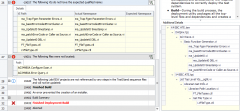Search the Community
Showing results for tags 'waveform'.
-
Hi folks, I need to know if this is possible? if yes then the what are the possibilities?? 1. The user should select the signals (by check box or similar). 2. My waveform chart should display only these signals on the front panel. (no of signals in the waveform chart must be modified based on this signals). 3. it is better, by clicking a button the new front panel pops up with waveform chart.
-
Hi, all I am doing now pulse oximeter project in labview. I have got signals from oximeter and waveform is generated in waveform graph. But not a smooth one. I need a smooth waveform like the image attached here. What are the applicable methods to solve this problem?
-
From the album: Can't access imgur
-
Hi there, I have an issue with a small project i'm currently working on, where I have an array of waveforms that I'm displaying on a graph. What I would like to do is to change the X-Axis from displaying the timestamp to displaying another channel. I have for instance a channel where force was recorded, and another where distance was recorded. I would now like to display force over distance for example. What would be the best way to do this? Would be thankful for any pointers on this matter. Robert.
-
A colleague of mine was tasked to create a program which takes as input 1000 data points each second along with two "masks", one for max and one for min, and the program will analyze and report TRUE if there is any section of the 1000 data points that fall perfectly in between the two masks. He wanted to do this in C++ but I told him this type of data analysis stuff sounds like LabVIEW's bread & butter. I browsed some of the Waveform VI's, especially the "Window" pallet but those don't seem to be what I want. I have an algorithm in mind to do this manually in LabVIEW, but id like some expert opinions if there is an easier way to do this with existing VI's before I attempt to remake the wheel; perhaps Open-G has something I can leverage as well? Just to drive home what I'm looking for, below is a visual picture of when the program would report back TRUE. I'm not sure how much this matters but I should mention that the two masks are NOT given as 1000 data points like the pulse to analyze is. Rather, since they are simple step functions they are given with level (V) + duration (ms) pairs. For example one of the masks could be described as: 0.1 250 10.0 500 0.1 250 Which means the pulse is 0.1 volts for 250ms then steps up to 10 volts for 500ms and then finally steps down to 0.1 volts again for the remaining 250ms. Thanks for your help!



